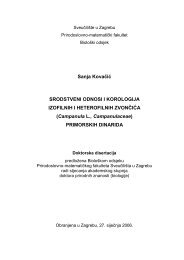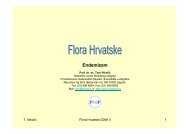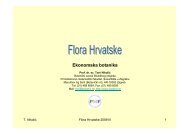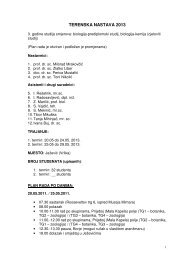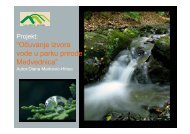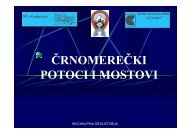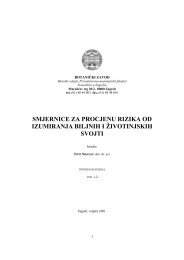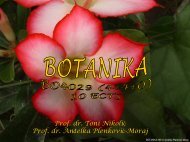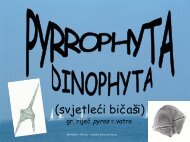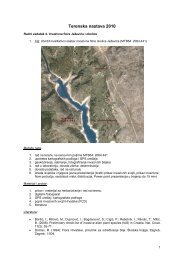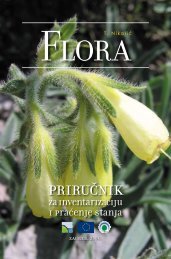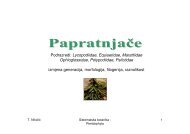important plant areas in central and eastern europe - hirc.botanic.hr ...
important plant areas in central and eastern europe - hirc.botanic.hr ...
important plant areas in central and eastern europe - hirc.botanic.hr ...
You also want an ePaper? Increase the reach of your titles
YUMPU automatically turns print PDFs into web optimized ePapers that Google loves.
MethodologyIPA site selection criteriaCriterionA(i)(t<strong>hr</strong>eatened species)A(ii)(t<strong>hr</strong>eatened species)A(iii)(t<strong>hr</strong>eatened species)DescriptionSite conta<strong>in</strong>s globally t<strong>hr</strong>eatenedspeciesSite conta<strong>in</strong>s regionally (European)t<strong>hr</strong>eatened speciesSite conta<strong>in</strong>s national endemicspecies with demonstrable t<strong>hr</strong>eatnot covered by A(i) or A(ii)Site conta<strong>in</strong>s near endemic/limitedrange species with demonstrablet<strong>hr</strong>eat not covered by A(i) or A(ii)T<strong>hr</strong>esholdAll sites known, thought or <strong>in</strong>ferredto conta<strong>in</strong> 5% or more of thenational population can be selected,or the 5 1 ‘best’ sites, whichever isthe most appropriate.NotesSpecies must be listed as‘t<strong>hr</strong>eatened’* on IUCN globalred listsSpecies must be listed as‘t<strong>hr</strong>eatened’* on EuropeanIUCN red list; or HabitatsDirective Annexes IIb & IVb;orBern Convention Appendix ISpecies must be listed asnational endemic (on anyrecognised list or publication)<strong>and</strong> ‘t<strong>hr</strong>eatened’* on nationalred listsSpecies must be listed as nearendemic/ limited range (on anyrecognised list or publication) <strong>and</strong>‘t<strong>hr</strong>eatened’* on national redlistsSpecies richness based onnationally created list of<strong>in</strong>dicator species created foreach habitat type <strong>and</strong> from thefollow<strong>in</strong>g types of species:characteristic species <strong>and</strong>/orendemic species <strong>and</strong> /ornationally rare <strong>and</strong> scarcespecies (where the endemic<strong>and</strong> rare <strong>and</strong> scarce species arenumerous <strong>and</strong>/or arecharacteristic for the habitat)Def<strong>in</strong>ed Habitat Type taken aslevel 2 (generic) habitat types <strong>in</strong>EUNIS (e.g. D1 raised & blanketbogs; G1 broad-leaveddeciduous forests; E1 drygrassl<strong>and</strong>s)A(iv)(t<strong>hr</strong>eatened species)1(In exceptional cases, for examplewhere there are less than 10 sites<strong>in</strong> the entire country or there arebetween 5-10 large populations of aspecies, up to 10 sites can beselected)(populations must be viable orthere is a hope that they can bereturned to viability t<strong>hr</strong>oughconservation measures)B(<strong>botanic</strong>al richness)Site conta<strong>in</strong>s high number ofspecies with<strong>in</strong> a range of def<strong>in</strong>edhabitat typesUp to 10% of the national resource(area) of level 2 EUNIS habitattypes, or 5 2 ‘best’ sites, whichever isthe most appropriate.2(In exceptional cases, for examplethere are between 5 <strong>and</strong> 10exceptionally rich sites for aparticular habitat, up to 10 sites canbe selected for each level 2 habitattype)C(i)Priority t<strong>hr</strong>eatened habitatsSite conta<strong>in</strong>s t<strong>hr</strong>eatened habitatAll sites known, thought or <strong>in</strong>ferredto conta<strong>in</strong> 5% or more of thenational resource (area) of priorityt<strong>hr</strong>eatened habitats can be selected,or a total of 20-60% of the nationalresource, whichever is the mostappropriate.Priority t<strong>hr</strong>eatened habitats arethose listed as priority onAnnex I of the HabitatsDirective (<strong>and</strong> anycorrespond<strong>in</strong>g habitat from theBern Convention Res. 4)C(ii)T<strong>hr</strong>eatened habitatsSite conta<strong>in</strong>s t<strong>hr</strong>eatened habitatAll sites known, thought or<strong>in</strong>ferred to conta<strong>in</strong> 5% or more ofthe national resource (area) can beselected, or the 5 3 ‘best’ sites,whichever is the most appropriate.T<strong>hr</strong>eatened habitats are thoselisted on Annex I of theHabitats Directive <strong>and</strong> the BernConvention Resolution 4, notcovered by C(i)3(In exceptional cases, for examplewhere there are less than 10 sites<strong>in</strong> the whole country, or there are5-10 exceptional sites, up to 10sites can be selected)* Criterion A, t<strong>hr</strong>eatened special must be listed as Critically Engangred (CR), Endangered (EN) or Vulnerable (VU) us<strong>in</strong>g the new IUCNcriteria, or Ext<strong>in</strong>ct/Endangered (Ex/E),Endangered (E) or Vulnerable (V) us<strong>in</strong>g the orig<strong>in</strong>al IUCN categories (pre 1994).Forest <strong>in</strong> Slovenia21



